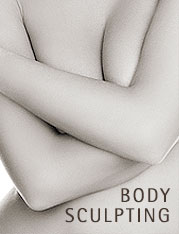Body Sculpting
Breast Augmentation (Augmentation Mammaplasty)
 One of the most frequently performed cosmetic surgery procedures in the U.S., breast augmentation can give women with small or unevenly sized breasts a fuller, firmer, better-proportioned look through the placement of implants behind the breast. Women elect to undergo breast augmentation for many different medical and aesthetic motivations, including balancing breast size and compensating for reduced breast size or fullness after pregnancy or surgery. The procedure may be combined with others such as a breast lift for more satisfying results.
One of the most frequently performed cosmetic surgery procedures in the U.S., breast augmentation can give women with small or unevenly sized breasts a fuller, firmer, better-proportioned look through the placement of implants behind the breast. Women elect to undergo breast augmentation for many different medical and aesthetic motivations, including balancing breast size and compensating for reduced breast size or fullness after pregnancy or surgery. The procedure may be combined with others such as a breast lift for more satisfying results.
Breast implants are soft silicone shells filled with saline (salt water) or cohesive silicone gel, and are placed behind each breast, underneath either breast tissue or, more commonly, the pectoral muscle. The procedure lasts one to two hours and is typically performed with general anesthesia, although local anesthesia combined with a sedative. After breast augmentation surgery the patient's bustline may be increased by one or more cup sizes.
Incisions are made in inconspicuous places on the breast to minimize scar visibility (in the crease on the underside of the breast, or around the areola, the dark skin around the nipple). The tissues are then lifted, creating a pocket into which the implant is inserted.
Placement behind the pectoral muscle offers advantages over placement beneath the breast tissue only. These include reduced risk of capsular contracture (post-operative scar tightening around the implant) and less interference with mammogram examinations.
After the implants are placed and centered beneath the nipples, incisions are stitched, taped and bandaged. In a few hours these bandages may be replaced with a surgical bra. Most patients feel tired and sore after breast augmentation surgery, but this usually passes in a day or two and many patients return to work within the week. Stitches dissolve in a week to 10 days and any post-operative pain, swelling and sensitivity will diminish over the first few weeks. Scars will begin to fade in a few months and will continue to fade for months or years.
Complications following breast augmentation surgery are uncommon. They may include scar capsular contracture, causing excessive firmness, infection around the implant, a change in nipple sensation, and breakage or leakage of the implant as a result of injury or the normal compression and movement of your breast (if this happens the implant will simply deflate in a few hours or days and the body will absorb the salt water harmlessly). The implant would then be replaced at no charge to the patient.
View before and after photos of Breast Augmentation »
Breast Reconstruction
Modern surgical technology makes it possible to construct a natural-looking breast after mastectomy (breast removal) for cancer or other diseases. The process is commonly begun and sometimes completed immediately following mastectomy, so that the patient wakes with a new breast mound instead of no breast at all. Alternatively, reconstruction may begin years after mastectomy. Many insurance companies cover reconstruction following breast cancer surgery, and legislation has been enacted in the state of New Jersey to make coverage mandatory.
Women whose cancer seems to have been eradicated with mastectomy are the best candidates for breast reconstruction. Those women who smoke are advised to wait. Some prefer to postpone reconstructive surgery as they come to terms with curing the cancer, consider the extent of the procedure, or explore alternatives.
The reconstruction itself consists of staged operations, the first of which involves creation of the breast mound and is performed during or after mastectomy in a hospital under general anesthesia. Later surgeries, if necessary, may be done in the hospital or an outpatient facility, usually under local anesthesia, with or without sedation.
There are several ways to reconstruct the breast, both with and without implants; your breast surgeon and Dr. Lipson should work together with you in deciding which approach is best for you.
Breast reconstruction has not been shown to affect the recurrence of cancer or other diseases, nor the success of chemotherapy or radiation treatment.
Nevertheless, in addition to the complications possible from any surgical procedure (hematoma, fluid collection, excessive scar tissue, or difficulties with anesthesia), there are some risks inherent in breast reconstruction, including infection around the implant, if an implant is used, and capsular contracture, when the scar (capsule) around the implant tightens, causing the breast to feel unnaturally firm. Treatment for capsular contracture varies from conservative, non-surgical methods to releasing or removing the scar tissue. Some patients may need time to adjust emotionally to the look and feel of their reconstruction. Also, the status of the opposite breast needs to be considered. Thus, reduction, lift or augmentation may be recommended opposite the reconstruction.
View before and after photos of Breast Reconstruction »
To learn more about our Plastic Surgery Services contact us today at 201.797.7770.





